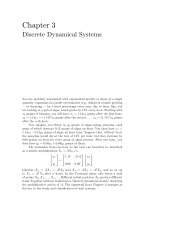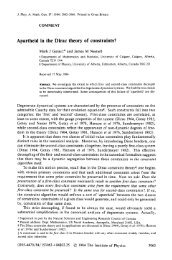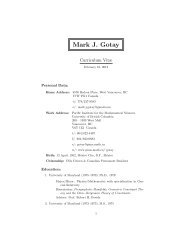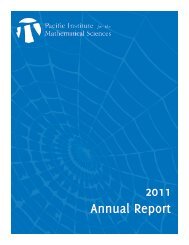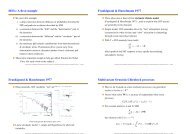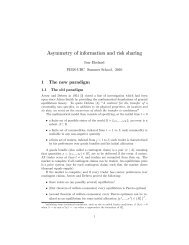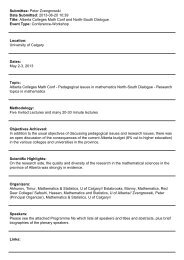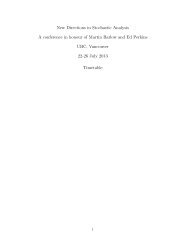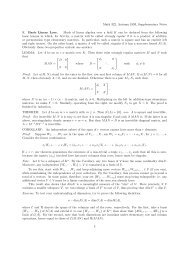21 PRIMA 2013 AbstractsSpecial Session 10Kinetic Equ<strong>at</strong>ionsOn some kinetic models for Bose Einstein condens<strong>at</strong>ionRadjesvarane AlexandreFrench Naval Academy, France and Shanghai Jiao TongUniversity, Chinaradjesvarane.alexandre@ecole-navale.frWe present some models based on kinetic equ<strong>at</strong>ions fordescribing Bose Einstein condens<strong>at</strong>ion. We will discussabout possible blow up or not of some of the partial differentialequ<strong>at</strong>ions. This is a joint work with Jie LIAOand Chunjin LIN.Angular averaging, propag<strong>at</strong>ion of exponentialtails and grazing collisions for solutions ofthe Boltzmann equ<strong>at</strong>ionIrene GambaUniversity of Texas <strong>at</strong> Austin, USAgamba@m<strong>at</strong>h.utexas.eduWe will discuss the interplay on the collision kernels propertiesof the Boltzmann equ<strong>at</strong>ion and the gener<strong>at</strong>ion andpropag<strong>at</strong>ion of summability of moments of the solutionfor the homogeneous initial value problem. Such summabilityyields global bounds for the solution of the Boltzmannequ<strong>at</strong>ion by exponentially weighted norms in L 1and pointwise, where the exponent depend on the initialst<strong>at</strong>e norms, the r<strong>at</strong>e of the intra-molecular potentials aswell as the integrability properties on the sphere (angularaveraging) for the sc<strong>at</strong>tering angle cross-section. We willalso discuss the impact of these estim<strong>at</strong>es in open problems,such as the grazing collision limits to the Landauequ<strong>at</strong>ion for Coulombic interactions. We will also shownumerical simul<strong>at</strong>ions of these limits for different crosssections.L p -sc<strong>at</strong>tering and uniform stability of kineticequ<strong>at</strong>ionsSeung-Yeal HaSeoul N<strong>at</strong>ional University, Koreasyha@snu.ac.krIn this talk, we will review recent progress on the L p -sc<strong>at</strong>tering and uniform stability of several kinetic equ<strong>at</strong>ionswith self-consistent forces. For the Vlasov equ<strong>at</strong>ionwith a self-consistent force, we will show th<strong>at</strong> theCoulomb’s potential in three dimensions is critical in thesense th<strong>at</strong> if sp<strong>at</strong>ial dimension is larger than three, thereexists a L 1 -sc<strong>at</strong>tering, whereas for low dimensions lessthan equal to three, there is no L 1 -sc<strong>at</strong>tering. We alsopresent a framework for the L p -stability of kinetic equ<strong>at</strong>ions.This is a joint work with Sun-Ho Choi (NUS) andQinghua Xiao (SNU).On the sp<strong>at</strong>ially homogeneous Boltzmann andLandau equ<strong>at</strong>ionsLingbing HeTsinghua University, Chinalbhe@m<strong>at</strong>h.tsinghua.edu.cnIn this talk, I will present some recent progress on thelower and upper bounds for the Boltzmann collision oper<strong>at</strong>or.As one applic<strong>at</strong>ion, we can build a unified frameworkto establish the well-posedness results for bothBoltzmann and Landau equ<strong>at</strong>ions. As another applic<strong>at</strong>ion,we will revisit the so-called "grazing collisions limit".It is shown th<strong>at</strong> when almost all collisions are grazing,th<strong>at</strong> is, the devi<strong>at</strong>ion angle θ of the collision is limitednear zero (i.e., θ ≤ ɛ), the solution f ɛ of the Boltzmannequ<strong>at</strong>ion with initial d<strong>at</strong>a f 0 can be globally or locallyexpanded asf ɛ = f + O(ɛ),for non Coulomb potential, orf ɛ = f + O(| log ɛ| −1 ),for Coulomb potential, where the function f is the solutionof Landau equ<strong>at</strong>ion, which is associ<strong>at</strong>ed to the grazingcollisions limit of Boltzmann equ<strong>at</strong>ion, with the sameinitial d<strong>at</strong>a f 0 . These give the rigorous justific<strong>at</strong>ion ofthe Landau approxim<strong>at</strong>ion in the sp<strong>at</strong>ially homogeneouscase.New regularity estim<strong>at</strong>es for transport equ<strong>at</strong>ionsPierre-Emmanuel JabinUniversity of Maryland, USApjabin@umd.eduWe present new regularity estim<strong>at</strong>es which are propag<strong>at</strong>edby transport equ<strong>at</strong>ions with rough coefficients.Those estim<strong>at</strong>es provides compactness on the density,which is a key ingredient to obtain existence of solutionsfor models from fluid mechanics (of the compressibleNavier-Stokes type) to chemotaxis. The correspondingspaces are defined <strong>at</strong> a logarithmic scale in terms of numberof deriv<strong>at</strong>ives and can thus be seen as intermediarybetween the usual L p and Sobolev spaces.Condens<strong>at</strong>ion and regularity for Boson Boltzmannequ<strong>at</strong>ionXuguang LuTsinghua University, Chinaxglu@m<strong>at</strong>h.tsinghua.edu.cnWe study the sp<strong>at</strong>ially homogeneous Boltzmann equ<strong>at</strong>ionfor Bose-Einstein particles for the hard sphere model. Weconsider the case where the initial d<strong>at</strong>um of a solution ofthe equ<strong>at</strong>ion is a function so th<strong>at</strong> there is no condens<strong>at</strong>ion(Dirac mass) <strong>at</strong> the initial st<strong>at</strong>e. We show th<strong>at</strong> if theinitial d<strong>at</strong>um is not very singular near the origin (the zeropointof particle energy) and if the kinetic temper<strong>at</strong>ureis sufficiently high, then the solution is also a functionfor all time, and it is a unique classical mild solutionof the equ<strong>at</strong>ion; whereas if the initial d<strong>at</strong>um is singularenough near the origin but still Lebesgue integrable, thenthe condens<strong>at</strong>ion of a corresponding solution continuouslystarts to occur from the initial time to every l<strong>at</strong>er time.Hamiltonian propag<strong>at</strong>ion of mono-kineticmeasures with rough initial profilesPeter MarkowichKing Abdullah University of Science and Technology,Kingdom of Saudi ArabiaP.A.Markowich@damtp.cam.ac.ukConsider in the phase space of classical mechanics aRadon measure which is a probability density carried bythe graph of a Lipschitz continuous (or even less regular)vector field. We study the structure of the push-forwardof such a measure by a Hamiltonian flow. In particular,we provide an estim<strong>at</strong>e on the number of folds in thesupport of the transported measure th<strong>at</strong> is the image ofthe initial graph by the flow. We also study in detail thetype of singularities in the projection of the transported
22 PRIMA 2013 Abstractsmeasure in configur<strong>at</strong>ion space (averaging out the momentumvariable). We study the conditions under whichthis projected measure can have <strong>at</strong>oms, and give an examplein which the projected measure is singular withrespect to the Lebesgue measure and diffuse. Finally, wediscuss applic<strong>at</strong>ions of our results to the classical limit ofthe SchrŽdinger equ<strong>at</strong>ion.Scalar conserv<strong>at</strong>ion laws and kinetic formul<strong>at</strong>ionBenoît PerthamePierre-and-Marie-Curie University, CNRS/INRIA andInstitut Universitaire de France, Franceperthame@ann.jussieu.frWe present a theory of Scalar Conserv<strong>at</strong>ion Laws withrough fluxes. The difficulty is th<strong>at</strong>, even with BV estim<strong>at</strong>es,the equ<strong>at</strong>ions does not make sense in disctributionalsense. Our approach is based on the kinetic formul<strong>at</strong>ionof conserv<strong>at</strong>ions laws.This theory leads n<strong>at</strong>urally to consider Kinetic AvergaingLemmas with random fluxes. On simple situ<strong>at</strong>ions wewill show the differences int he gain of regularity.This talk is based on works with P.-L. Lions and P. E.Souganidis.Kinetic description of bacterial motion bychemotaxis and asymptoticsNicolas VaucheletPierre-and-Marie-Curie University, Francevauchelet@ann.jussieu.frChemotaxis is the phenomenon in which cells direct theirmotion according to a chemical present in their environment.Since experimental observ<strong>at</strong>ions have shown th<strong>at</strong>the motion of bacteria (e.g. Escherichia Coli) is due tothe altern<strong>at</strong>ion of ‘runs and tumbles’, m<strong>at</strong>hem<strong>at</strong>ical modellingthanks to a kinetic description has been proposed.The starting point of the study is the so-called Othmer-Dunbar-Alt model governing the dynamics of the distributionfunction f of cells <strong>at</strong> time t, position x and velocityv, assumed to have a constant modulus c > 0, as wellas the concentr<strong>at</strong>ion S(t, x) of the involved chemical. Ageneral formul<strong>at</strong>ion for this model can be written as⎧⎪⎨⎪⎩∂ tf + v · ∇ xf = Q(f),Q(f) = ∫ (|v ′ |=c T [S](v ′ , v)f(v ′ )−T [S](v, v ′ )f(v) ) ∫ dv ′ ,−∆S + S = ρ(t, x) := f(t, x, v) dv.|v|=cThe third equ<strong>at</strong>ion describes the dynamics of the chemicalagent which diffuses in the domain. It is producedby the cells themselves with a r<strong>at</strong>e proportional to thedensity of cells ρ and disappears with a r<strong>at</strong>e proportionalto S. The transport oper<strong>at</strong>or on the left-hand side of thefirst equ<strong>at</strong>ion stands for the unbiased movement of cells(‘runs’), while the right-hand side governs ‘tumbles’, th<strong>at</strong>is chemotactic orient<strong>at</strong>ion, or taxis, through the turningkernel T [S](v ′ , v), which is the r<strong>at</strong>e of cells changing theirvelocity from v ′ to v.In this work, we focus on positive chemotaxis whichmeans th<strong>at</strong> the involved chemical S is <strong>at</strong>tracting cells,called chemo<strong>at</strong>tractant. Existence results for this systemhas been obtained for various assumptions on the turningkernel. Macroscopic model can be derived from thissystem of equ<strong>at</strong>ions after a rescaling. When the taxis issmall compared to the unbiased movement of cells, thescaling must be of diffusive type, so th<strong>at</strong> the limit equ<strong>at</strong>ionsare of diffusion or drift-diffusion type. When taxisdomin<strong>at</strong>es the unbiased movements, a hyperbolic limitcan be derived, leading to aggreg<strong>at</strong>ion equ<strong>at</strong>ions. Moreover,experimental observ<strong>at</strong>ions have shown the form<strong>at</strong>ionof traveling pulse of bacteria in micro-channel. The abovem<strong>at</strong>hem<strong>at</strong>ical modeling allows to recover this behaviour,which motiv<strong>at</strong>es the interest on such system.Viscous wave propag<strong>at</strong>ion <strong>at</strong> interfaceShih-Hsien YuN<strong>at</strong>ional University of Singapore, Singaporem<strong>at</strong>ysh@nus.edu.sgIn this talk we implement the LY algorithm to derive <strong>at</strong>wo-sided master rel<strong>at</strong>ionship. This gives rise the oper<strong>at</strong>orto construct the surface wave <strong>at</strong> the interface and theconstruction of the Green’s function of a simple variablecoefficient problem for viscous conserv<strong>at</strong>ion laws.Special Session 11M<strong>at</strong>hem<strong>at</strong>ical Fluid Dynamics and Rel<strong>at</strong>edTopicsGlobal solutions of the equivariant he<strong>at</strong>-flowStephen GustafsonUniversity of British Columbia, Canadagustaf@m<strong>at</strong>h.ubc.caThe harmonic map he<strong>at</strong>-flow is a canonical, parabolic,geometric evolution equ<strong>at</strong>ion, which is (energy) criticalin two dimensions. I will present a global regularity resultfor the equivariant, higher-degree, above-thresholdhe<strong>at</strong>-flow into the sphere, which extends to higher energiesearlier work with Nakanishi and Tsai on the he<strong>at</strong>and Schroedinger flows. This is joint work with DimitriosRoxanas.Well-posedness of coupled kinetic-fluid modelsfor flockingSeung-Yeal HaSeoul N<strong>at</strong>ional University, Koreasyha@snu.ac.krIn this talk, I will present several kinetic-fluid models forflocking. More precisely, I will discuss the dynamics ofCucker-Smale flocking particles interacting with neighboringcompressible and incompressible fluid. For suchcoupled kinetic-fluid models, we will show global existenceof weak and strong solutions and asymptotic flockingestim<strong>at</strong>es for small initial d<strong>at</strong>a and large viscosities.This is a joint work with H.O.Bae (Ajou Univ), Young-PilChoi (Imperial College of London) and Moon-Jin Kang(SNU).Global classical and weak solutions to the 3Dfully compressible Navier-Stokes-Fourier systemXiangdi HuangAcademy of M<strong>at</strong>hem<strong>at</strong>ics and System Sciences, CAS,Chinaxdhuang@amss.ac.cnWe establish the global existence and uniqueness of classicalsolutions to the three-dimensional fully compressibleNavier-Stokes-Fourier system with smooth initial d<strong>at</strong>awhich are of small energy but possibly large oscill<strong>at</strong>ionswhere the initial density is allowed to vanish. Moreover,for the initial d<strong>at</strong>a, which may be discontinuous and containvacuum st<strong>at</strong>es, we also obtain the global existenceof weak solutions. These results generalize previous oneson classical and weak solutions for initial density being
- Page 2 and 3:
1PRIMA 2013-Table of ContentsTable
- Page 4 and 5:
3PRIMA 2013-OrganizationOrganizatio
- Page 6 and 7:
5PRIMA 2013-OrganizationYoshikazu G
- Page 8 and 9:
7PRIMA 2013-Useful InformationUsefu
- Page 10 and 11:
9PRIMA 2013-Useful InformationTaxi:
- Page 12 and 13:
11PRIMA 2013-Useful Informationmath
- Page 14 and 15:
13PRIMA 2013 Program-Schedule-at-a-
- Page 16 and 17:
15PRIMA 2013 Program-Monday, June 2
- Page 18 and 19: 17PRIMA 2013 Program-Monday, June 2
- Page 20 and 21: 19PRIMA 2013 Program-Monday, June 2
- Page 22 and 23: 21PRIMA 2013 Program-Monday, June 2
- Page 24 and 25: 23PRIMA 2013 Program-Tuesday, June
- Page 26 and 27: 25PRIMA 2013 Program-Tuesday, June
- Page 29 and 30: 28PRIMA 2013 Program-Tuesday, June
- Page 31 and 32: 30PRIMA 2013 Program-Tuesday, June
- Page 33 and 34: 32PRIMA 2013 Program-Wednesday, Jun
- Page 35 and 36: 34PRIMA 2013 Program- Thursday, Jun
- Page 37 and 38: 36PRIMA 2013 Program- Thursday, Jun
- Page 39 and 40: 38PRIMA 2013 Program- Thursday, Jun
- Page 41 and 42: 40PRIMA 2013 Program- Thursday, Jun
- Page 43 and 44: 42PRIMA 2013 Program- Friday, June
- Page 45 and 46: 44PRIMA 2013 Program- Friday, June
- Page 48 and 49: 1 PRIMA 2013 AbstractsContents1 Pub
- Page 50 and 51: 3 PRIMA 2013 Abstractsof subfactors
- Page 52 and 53: 5 PRIMA 2013 AbstractsprocessesXu S
- Page 54 and 55: 7 PRIMA 2013 AbstractsIn this talk
- Page 56 and 57: 9 PRIMA 2013 Abstractsindependently
- Page 58 and 59: 11 PRIMA 2013 AbstractsEnumerating,
- Page 60 and 61: 13 PRIMA 2013 AbstractsRyuhei Uehar
- Page 62 and 63: 15 PRIMA 2013 AbstractsIn this talk
- Page 64 and 65: 17 PRIMA 2013 AbstractsSpecial Sess
- Page 66 and 67: 19 PRIMA 2013 Abstractscritical slo
- Page 70 and 71: 23 PRIMA 2013 Abstractsstrictly awa
- Page 72 and 73: 25 PRIMA 2013 AbstractsPedram Hekma
- Page 74 and 75: 27 PRIMA 2013 Abstractsis well-know
- Page 76 and 77: 29 PRIMA 2013 Abstractssolid substr
- Page 78 and 79: 31 PRIMA 2013 AbstractsRapoport-Zin
- Page 80 and 81: 33 PRIMA 2013 Abstractssense. Our a
- Page 82 and 83: 35 PRIMA 2013 AbstractsIn an econom
- Page 84 and 85: 37 PRIMA 2013 AbstractsKyoto Univer
- Page 86 and 87: 39 PRIMA 2013 AbstractsAlexander Mo
- Page 88 and 89: 41 PRIMA 2013 AbstractsOsamu SaekiK
- Page 90 and 91: 43 PRIMA 2013 Abstractsopen Delzant
- Page 92 and 93: 45 PRIMA 2013 AbstractsJian ZhouTsi
- Page 94 and 95: 47 PRIMA 2013 AbstractsJiaqun WeiNa
- Page 96 and 97: 49 PRIMA 2013 Abstractsthe end of 2
- Page 98 and 99: 51 PRIMA 2013 AbstractsJongyook Par
- Page 100 and 101: 53 PRIMA 2013 AbstractsPancyclicity
- Page 102 and 103: 55 PRIMA 2013 AbstractsEfficient nu
- Page 104 and 105: 57 PRIMA 2013 Abstractsand fountain
- Page 106: 59 PRIMA 2013 Abstractsformula esti



